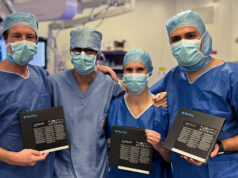Aortica Corporation has announced that Benjamin Starnes, chief of Vascular Surgery at the University of Washington, completed the first three-vessel fenestrated endovascular aneurysm repair (FEVAR) using Aortica’s AortaFit investigational automated case planning software and Bolton Medical’s Treo abdominal stent graft system as part of his physician-sponsored IDE study.
FEVAR is an effective treatment for more complex AAA cases in which fenestrations are carefully placed on the endograft to line up with branch arteries that supply blood to vital organs. These branch arteries preclude reliably anchoring a standard graft. While highly effective, FEVAR is also highly complex and time-consuming given the technology available today. Starnes’ IDE study is evaluating technologies and methods to dramatically simplify FEVAR. The AortaFit planning software has been a key part of the study since February, and with the addition of Treo, Starnes has used the AortaFit software with a total of five different endograft systems. Treo is an investigational abdominal aortic aneurysm endograft developed by Bolton Medical. Treo is available commercially outside the USA, but is still investigational within the USA. Starnes recently received FDA approval to add the Treo to his IDE study.
The patient was a 68-year-old male with a 6cm aneurysm and a history of heart disease and COPD. He also had significant angulation of the aorta. The procedure took less than two hours, and the patient was released from the hospital two days later.
“This is a patient with very challenging aortic anatomy,” stated Starnes. “The arteries that supplied his kidneys were 10mm from the origin of the aneurysm, meaning there was not adequate space to anchor a standard endograft. In addition, the angulation of the vessel posed a challenge to accurately aligning the graft fenestrations with the branch arteries. Patients with this level of complexity end up with very few treatment options other than maximally invasive open surgery,” he explained. “AortaFit’s automated planning software enabled me to accurately and quickly generate a three-fenestration graft. I was excited to use Treo for the first time because its design provides a nice mix of mechanical support and flexibility. This gave the endograft strong scaffolding characteristics, while still providing me a great deal of ‘strut-free’ area to place the fenestrations. The flexibility of Treo enabled me to easily navigate the vessel angulation.” He continued, “I could place the graft higher up in the aorta to achieve a secure anchor and a great seal while still preserving blood flow to the kidneys and stomach. In all, we placed a graft that precisely matched the patient’s anatomy, and we increased the effective seal zone length from 10mm to 54mm. This is a key factor in achieving a result that is not only effective in the short term, but durable for the long term.”
“We have been fortunate over the past year to include our automated case planning software in Dr Starnes IDE study as this has allowed us to demonstrate its ability to eliminate hours of upfront planning and complexity in a clinical setting,” stated Aortica CEO Tom Douthitt. “But our software is just one piece of a comprehensive approach we have taken toward simplifying the entire FEVAR procedure. The AortaFit System is comprised of two additional technology platforms currently under development—a process for quickly applying fenestrations to standard endografts at the manufacturing site and a purpose-built branch fenestration stent. We hope to advance all three platforms in a pivotal trial in the near future.”













